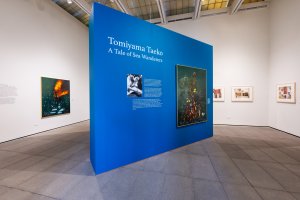By Land, Sea, Myth, and Imperialist Greed (Santa Barbara Independent)
UC Santa Barbara AD&A Museum Showcases Acquisition of Art by Important Japanese Artist Tomiyama Taeko, Critical of Her Homeland’s Imperialist Legacies
By Josef Woodard
Thu Mar 13, 2025 | 10:43am
On the rich and inviting face of it, the art of Tomiyama Taeko, the important but underappreciated Japanese artist who lived from 1921 to 2021, seduces the eye and imagination with its elaborate and fantastical iconography. Looking and seeing her art is its own reward.
But, as seen in the fascinating exhibition at UCSB AD&A Museum, Tomiyama Taeko: A Tale of Sea Wanderers, beyond her focus on the “other” worlds of puppetry, mythology, and undersea surrealist vision, the artist’s underlying concern for real-world issues, including environmental alarm. More specifically, Taeko, born in Japan but raised in China before returning for art studies, often folds into her work a passionate and critical indictment of Japan’s harsh imperialist tendencies, seen in the extreme in the Sino-Japanese War (1937-1945) and during World War II.
For that reason, her art has been embraced more in Korea than her native land, a nation reluctant to consider moral or other reparations for its WWII misdeeds (including scars left in Korea, with its “comfort women” stigma).
This UCSB showing — unveiling a gift to the museum of 28 works from her Hiruko series — assumes art-worldly significance for helping to spread awareness of her special gifts. The exhibition was curated by the museum’s director, Gabe Ritter, assisted by Hayate Murayama, a doctoral student specializing in Japanese history and war memory.
Hiruko, also known as Ebisu, is a god of fisherman and luck in Japanese mythology, and a framework for Taeko’s artistic overview in this series, circa 2008. As a kind of centerpiece in the show, Taeko’s large canvas “Theater Beneath the Sea: Splendid Banquet for the Empire” commands attention upon entering the museum’s high-ceilinged entryway gallery. In this undersea pageantry, the sense of mystery and wonder of its deep-sea context and lurking/dancing sea life is offset by pictorial allusions to spoils of war and gaudy materialistic excess. Puppetry takes center stage and center staging in the strangely mesmerizing painting “Wandering Minstrels and Puppeteers,” a rogue’s gallery of puppets, masks, and other regalia plucked from across a range of history and cultures. The artist herself is slyly tucked into the lower corner of the busy ensemble of figures — serving as both puppeteer and compositional proxy.
Amid the exhibition’s artistic composite of poetic and allegorical commentaries, a more real and direct historical subject greets us with the painting “In Toxic Seas,” depicting the burning twin towers of 9/11 infamy, but in a murky sea setting. The piece also nods to ecological peril while functioning as a harbinger of the long war(s) to come from the World Trade Center ashes.
In the smaller side gallery, the deep-sea fantasy zone continues, with poetic texts illustrating in verbal imagery the artistic statements. One wavy text on the wall reads “Icebergs melt and floods come. Fragments of a broken world would drift ashore,” adjacent to a pair of oil and mixed-media pieces under the moniker “Adrift.” In these, embedded in a watery background, are clumped masses of abstracted data and found-object flotsam — a watch, beads, cat buttons, a chaotic but amiable mesh.
In the painting “They Wandered Sea Roads,” jellyfish maneuver freely in this enigmatic world, alongside a deity’s unattached head and an ornamental, shrine-like object cast into the depths.
More explicit cultural and militaristic references are woven into the graceful but loaded collage series “Rough Seas: The Age of Exploitation,” with decorative fragments interspersed with images of historical warlike aggressions and imperial ambitions.
Taking in the enlightening full measure of Taeko’s art here, we feel immersed — aptly enough — in the artist’s consistent and creative expressive voice. Hers is an admirably layered aesthetic and highly personal art, resistant to easy explanation or inclusion in any specific contemporary art school of thought. She plunges us into another world and way of seeing, while somehow unflinchingly taking on oppressive national traits and transgressions.
Maybe this delicate duality of perspective on art versus a cruel sociopolitical reality is a worthy model of artistic approach in the troubled waters of our very present and pressured time.
Tomiyama Taeko: A Tale of Sea Wanderers is on view at UCSB AD&A Museum through April 27. For more information, see museum.ucsb.edu/news/feature/1146.

